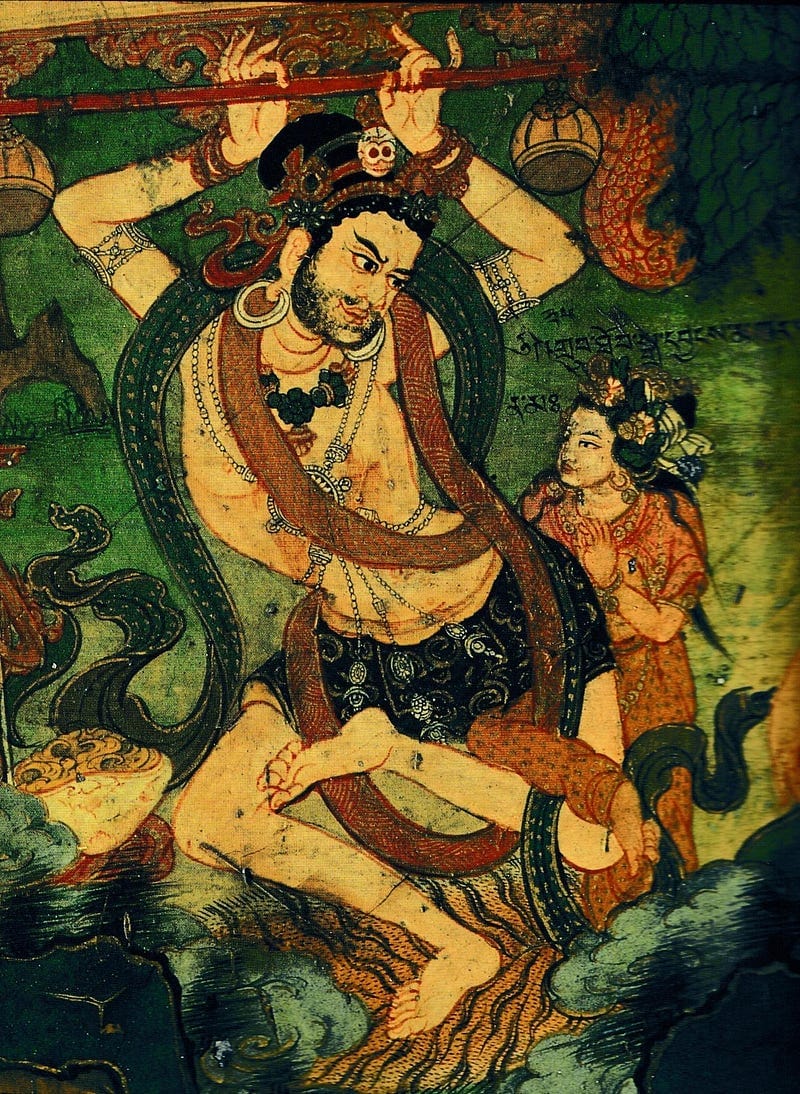A close friend sent me a picture of one of the Eighty-Four “Masters of Mahamudra,” whose name was Vīnapā. Vīnapā accomplished Mahāmudrā by meditating on the Inner Spontaneous Sounds. I thought I would share his story with you:
With perseverance and devotion
I mastered the vīṇā’s errant chords;
but then practicing the unborn, unstruck sound
I, Vīṇāpa, lost my self.
Vīṇāpa, master of the vīṇā, a complex stringed instrument, was born into the royal House of Gauda. His Guru was Buddhapa, who gained his siddhi from Hevajra.
The prince was indeed struck by the qualities of this holy man, and at the first encounter he prostrated to him and circumambulated him, and they sat down together to talk frankly about life’s problems. Very soon Buddhapa realized that the prince was ready for spiritual training, and he asked him how he felt about practicing a sādhana, a method of disciplining the mind on the path to Buddhahood.
“My Sadhana is my music, venerable yogin,” replied the prince. “I am totally preoccupied with my vīṇā and fascinated by the sound of the tambura. But if there is a Buddhist Sadhana that I could learn without abandoning any music I would certainly practice it.”
“If you have the motivation and faith necessary to practice, I will teach you a musical Sadhana,” the guru promised him.
The guru Buddhapa initiated the prince with the initiation that mellows the immature mind-stream. His meditation instruction was this: meditate upon the sound of your instrument free of all distinction between the sound struck and the mental impression; cease all mental interference with the sound, all conceptualization and all critical and judgmental thought, so that you contemplate only pure sound.
The prince practiced these precepts for nine years, and all mental obscurations obstructing pure cognition were eradicated from his mind. His mastery of the “unborn, unstruck sound” was made audible by eradication of concepts, judgments, comparisons and criticism that obscure cognition of the pure sound. After experiencing the clear light shining within like a butter lamp, he attained Mahāmudrā.¹
Of course, my purpose in sharing this story and picture of this master of Mahāmudrā is not to entertain you, but to point out the very important and easily overlooked reference to scholarly facts and concepts, judgements and comparisons, as well as criticisms, which become blockages to our meditative development.

Some important links:
If The Self Is An Illusion, Who Is It That Is Experiencing That Illusion?
The Recurring Misunderstanding Of The Buddhist Doctrine Of Emptiness And What We Can Learn From It In Light Of Our Present Need For A Paradigm Shift.
This essay, while answering the question in its title, exemplifies the distinction between scholastic knowledge and direct illumination, and why we all may not know what we are talking about, even when we have all the facts.

The next two essays are ‘must reads’ because they both illustrate the distinction between scholastic knowledge and direct illumination, and how scholarship without practice can undermine the Dharma, much as it has undermined modern education with its focus on memorizing facts, rather than learning how to develop those facts oneself.
It has to do with what has been framed as a dispute among scholars, so it is seemingly unimportant, and yet, that dispute has kept a particular Mahayana teaching from students of Tibetan Buddhism for over twelve-hundred years, while it has meanwhile been ranked as one of the most important (top four) sutras in Ch’an and Zen Buddhism for over a millennia. This is how scholarship becomes marā — that which puts an end to practice — and this is the underlying subject of both of these essays.
These essays are polemics, rather than scholarly papers genteelly asserting a different opinion, meant to be filed away under the label of “TLDR;” They are a defense of the Dharma, and Khenpo Sodargye, a renowned Tibetan lama and the head of the Larung Gar Tibetan Monastery, has called for all students of the Dharma to right this wrong by “eradicating” these false ideas and scandalous slanders of the Surangama Sutra by scholars. You can hear his words here: https://tranquillitysecret.files.wordpress.com/2022/09/eradicating-wrong-ideas.mp3

The purpose of these two articles then is to undo twelve-hundred years of calumny by scholars against one particular teaching of Buddha because the teaching directly attacks the idea that knowledge alone can save us. The Buddha sternly rebukes that idea in the sutra, saying that without practice, all knowledge of his teachings are useless.
You may ask, who am I to settle a scandal that has been simmering for over a thousand years? I certainly ask it. But you see, I have newly uncovered evidence that the whole scandalous criticism of the Surangama Sutra is based on a falsehood.
Today, in the wider world, we are facing very difficult times, and this particular sutra provides us with a practical means to get through difficulties such as these — practical means not found in any other teaching of Buddha.
And interestingly, we see exactly the same widespread idea being raised in reply to our global challenges ahead — that only knowledge and experts will save us, and that there is no need for any change in our behavior — our daily practice, in other words. How to accomplish that behavioral change is given in the Surangama Sutra.
If you have the Medium application on your phone, you can listen to these and the rest of Tranquillity’s Secret by tapping the circle with the ‘play’ icon at the very top-middle of the screen. If you are using a browser, the play button is the blue-green “Listen” icon at the top-middle of the article page.
One of the Most Cherished Sutras in Ch’an and Zen Buddhism Has Never Been Taught in Tibetan Buddhism. Why Not?
The True History of the Complete Instructions for the Practice and Realizations of the Buddha’s Secret Path — A Cautionary Tale
How Malcolm Smith’s Campaign to Undermine the Surangama Sutra on Social Media Undermines the Mahayana
A Modern Example Of How The Buddha’s Teachings Become Lost When Scholars Create Doubt About Their Authenticity

Footnote:
¹ Taken from: “Masters of Mahamudra — Songs and Histories of the Eighty-Four Buddhist Siddhas,” by Keith Dowman, SUNY Press, 1985, pgs 91–93

